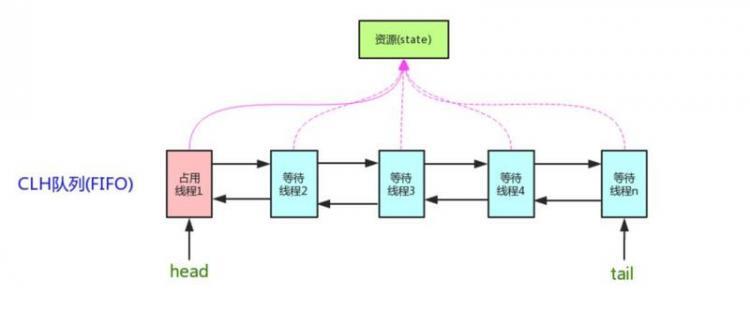【Java】Java并发编程之CAS和AQS
Java并发编程之CAS和AQS
入门小站发布于 1 月 28 日
什么是CAS
public final boolean compareAndSet(int expect, int update) {return unsafe.compareAndSwapInt(this, valueOffset, expect, update);
}
CAS的应用
public class AtomicInteger extends Number implements java.io.Serializable {private static final long serialVersionUID = 6214790243416807050L;
// setup to use Unsafe.compareAndSwapInt for updates
private static final Unsafe unsafe = Unsafe.getUnsafe();
private volatile int value;// 初始int大小
// 省略了部分代码...
// 带参数构造函数,可设置初始int大小
public AtomicInteger(int initialValue) {
value = initialValue;
}
// 不带参数构造函数,初始int大小为0
public AtomicInteger() {
}
// 获取当前值
public final int get() {
return value;
}
// 设置值为 newValue
public final void set(int newValue) {
value = newValue;
}
//返回旧值,并设置新值为 newValue
public final int getAndSet(int newValue) {
/**
* 这里使用for循环不断通过CAS操作来设置新值
* CAS实现和加锁实现的关系有点类似乐观锁和悲观锁的关系
* */
for (;;) {
int current = get();
if (compareAndSet(current, newValue))
return current;
}
}
// 原子的设置新值为update, expect为期望的当前的值
public final boolean compareAndSet(int expect, int update) {
return unsafe.compareAndSwapInt(this, valueOffset, expect, update);
}
// 获取当前值current,并设置新值为current+1
public final int getAndIncrement() {
for (;;) {
int current = get();
int next = current + 1;
if (compareAndSet(current, next))
return current;
}
}
// 此处省略部分代码,余下的代码大致实现原理都是类似的
}
//有线程安全问题public class Counter {
private int count;
public Counter(){}
public int getCount(){
return count;
}
public void increase(){
count++;
}
}
//悲观锁,线程安全,缺点性能差public class Counter {
private int count;
public Counter(){}
public synchronized int getCount(){
return count;
}
public synchronized void increase(){
count++;
}
}
//乐观锁,线程安全,性能好public class Counter {
private AtomicInteger count = new AtomicInteger();
public Counter(){}
public int getCount(){
return count.get();
}
public void increase(){
count.getAndIncrement();
}
}
CAS的三大缺点
ABA问题
循环时间长开销大
只能保证一个共享变量的原子操作
什么是AQS
AQS的应用
boolean tryAcquire(int arg)boolean tryRelease(int arg)
int tryAcquireShared(int arg)
boolean tryReleaseShared(int arg)
boolean isHeldExclusively()
public class CountDownLatch {/**
* 基于AQS的内部Sync
* 使用AQS的state来表示计数count.
*/
private static final class Sync extends AbstractQueuedSynchronizer {
private static final long serialVersionUID = 4982264981922014374L;
Sync(int count) {
// 使用AQS的getState()方法设置状态
setState(count);
}
int getCount() {
// 使用AQS的getState()方法获取状态
return getState();
}
// 覆盖在共享模式下尝试获取锁
protected int tryAcquireShared(int acquires) {
// 这里用状态state是否为0来表示是否成功,为0的时候可以获取到返回1,否则不可以返回-1
return (getState() == 0) ? 1 : -1;
}
// 覆盖在共享模式下尝试释放锁
protected boolean tryReleaseShared(int releases) {
// 在for循环中Decrement count直至成功;
// 当状态值即count为0的时候,返回false表示 signal when transition to zero
for (;;) {
int c = getState();
if (c == 0)
return false;
int nextc = c-1;
if (compareAndSetState(c, nextc))
return nextc == 0;
}
}
}
private final Sync sync;
// 使用给定计数值构造CountDownLatch
public CountDownLatch(int count) {
if (count < 0) throw new IllegalArgumentException("count < 0");
this.sync = new Sync(count);
}
// 让当前线程阻塞直到计数count变为0,或者线程被中断
public void await() throws InterruptedException {
sync.acquireSharedInterruptibly(1);
}
// 阻塞当前线程,除非count变为0或者等待了timeout的时间。当count变为0时,返回true
public boolean await(long timeout, TimeUnit unit)
throws InterruptedException {
return sync.tryAcquireSharedNanos(1, unit.toNanos(timeout));
}
// count递减
public void countDown() {
sync.releaseShared(1);
}
// 获取当前count值
public long getCount() {
return sync.getCount();
}
public String toString() {
return super.toString() + "[Count = " + sync.getCount() + "]";
}
}
AQS 原理
* +------+ prev +-----+ +-----+* head | | <---- | | <---- | | tail
* +------+ +-----+ +-----+

简单源码分析
public final void acquire(int arg) {// 首先尝试获取,不成功的话则将其加入到等待队列,再for循环获取
if (!tryAcquire(arg) &&
acquireQueued(addWaiter(Node.EXCLUSIVE), arg))
selfInterrupt();
}
// 从clh中选一个线程获取占用资源
final boolean acquireQueued(final Node node, int arg) {
boolean failed = true;
try {
boolean interrupted = false;
for (;;) {
// 当节点的先驱是head的时候,就可以尝试获取占用资源了tryAcquire
final Node p = node.predecessor();
if (p == head && tryAcquire(arg)) {
// 如果获取到资源,则将当前节点设置为头节点head
setHead(node);
p.next = null; // help GC
failed = false;
return interrupted;
}
// 如果获取失败的话,判断是否可以休息,可以的话就进入waiting状态,直到被unpark()
if (shouldParkAfterFailedAcquire(p, node) &&
parkAndCheckInterrupt())
interrupted = true;
}
} finally {
if (failed)
cancelAcquire(node);
}
}
private Node addWaiter(Node mode) {
// 封装当前线程和模式为新的节点,并将其加入到队列中
Node node = new Node(Thread.currentThread(), mode);
// Try the fast path of enq; backup to full enq on failure
Node pred = tail;
if (pred != null) {
node.prev = pred;
if (compareAndSetTail(pred, node)) {
pred.next = node;
return node;
}
}
enq(node);
return node;
}
private Node enq(final Node node) {
for (;;) {
Node t = tail;
if (t == null) {
// tail为null,说明还没初始化,此时需进行初始化工作
if (compareAndSetHead(new Node()))
tail = head;
} else {
// 否则的话,将当前线程节点作为tail节点加入到CLH中去
node.prev = t;
if (compareAndSetTail(t, node)) {
t.next = node;
return t;
}
}
}
}
关注微信公众号:【入门小站】,解锁更多知识点。

java多线程
阅读 50发布于 1 月 28 日
本作品系原创,采用《署名-非商业性使用-禁止演绎 4.0 国际》许可协议
入门小站
rumenz.com
47 声望
3 粉丝
入门小站
rumenz.com
47 声望
3 粉丝
宣传栏
目录
什么是CAS
public final boolean compareAndSet(int expect, int update) {return unsafe.compareAndSwapInt(this, valueOffset, expect, update);
}
CAS的应用
public class AtomicInteger extends Number implements java.io.Serializable {private static final long serialVersionUID = 6214790243416807050L;
// setup to use Unsafe.compareAndSwapInt for updates
private static final Unsafe unsafe = Unsafe.getUnsafe();
private volatile int value;// 初始int大小
// 省略了部分代码...
// 带参数构造函数,可设置初始int大小
public AtomicInteger(int initialValue) {
value = initialValue;
}
// 不带参数构造函数,初始int大小为0
public AtomicInteger() {
}
// 获取当前值
public final int get() {
return value;
}
// 设置值为 newValue
public final void set(int newValue) {
value = newValue;
}
//返回旧值,并设置新值为 newValue
public final int getAndSet(int newValue) {
/**
* 这里使用for循环不断通过CAS操作来设置新值
* CAS实现和加锁实现的关系有点类似乐观锁和悲观锁的关系
* */
for (;;) {
int current = get();
if (compareAndSet(current, newValue))
return current;
}
}
// 原子的设置新值为update, expect为期望的当前的值
public final boolean compareAndSet(int expect, int update) {
return unsafe.compareAndSwapInt(this, valueOffset, expect, update);
}
// 获取当前值current,并设置新值为current+1
public final int getAndIncrement() {
for (;;) {
int current = get();
int next = current + 1;
if (compareAndSet(current, next))
return current;
}
}
// 此处省略部分代码,余下的代码大致实现原理都是类似的
}
//有线程安全问题public class Counter {
private int count;
public Counter(){}
public int getCount(){
return count;
}
public void increase(){
count++;
}
}
//悲观锁,线程安全,缺点性能差public class Counter {
private int count;
public Counter(){}
public synchronized int getCount(){
return count;
}
public synchronized void increase(){
count++;
}
}
//乐观锁,线程安全,性能好public class Counter {
private AtomicInteger count = new AtomicInteger();
public Counter(){}
public int getCount(){
return count.get();
}
public void increase(){
count.getAndIncrement();
}
}
CAS的三大缺点
ABA问题
循环时间长开销大
只能保证一个共享变量的原子操作
什么是AQS
AQS的应用
boolean tryAcquire(int arg)boolean tryRelease(int arg)
int tryAcquireShared(int arg)
boolean tryReleaseShared(int arg)
boolean isHeldExclusively()
public class CountDownLatch {/**
* 基于AQS的内部Sync
* 使用AQS的state来表示计数count.
*/
private static final class Sync extends AbstractQueuedSynchronizer {
private static final long serialVersionUID = 4982264981922014374L;
Sync(int count) {
// 使用AQS的getState()方法设置状态
setState(count);
}
int getCount() {
// 使用AQS的getState()方法获取状态
return getState();
}
// 覆盖在共享模式下尝试获取锁
protected int tryAcquireShared(int acquires) {
// 这里用状态state是否为0来表示是否成功,为0的时候可以获取到返回1,否则不可以返回-1
return (getState() == 0) ? 1 : -1;
}
// 覆盖在共享模式下尝试释放锁
protected boolean tryReleaseShared(int releases) {
// 在for循环中Decrement count直至成功;
// 当状态值即count为0的时候,返回false表示 signal when transition to zero
for (;;) {
int c = getState();
if (c == 0)
return false;
int nextc = c-1;
if (compareAndSetState(c, nextc))
return nextc == 0;
}
}
}
private final Sync sync;
// 使用给定计数值构造CountDownLatch
public CountDownLatch(int count) {
if (count < 0) throw new IllegalArgumentException("count < 0");
this.sync = new Sync(count);
}
// 让当前线程阻塞直到计数count变为0,或者线程被中断
public void await() throws InterruptedException {
sync.acquireSharedInterruptibly(1);
}
// 阻塞当前线程,除非count变为0或者等待了timeout的时间。当count变为0时,返回true
public boolean await(long timeout, TimeUnit unit)
throws InterruptedException {
return sync.tryAcquireSharedNanos(1, unit.toNanos(timeout));
}
// count递减
public void countDown() {
sync.releaseShared(1);
}
// 获取当前count值
public long getCount() {
return sync.getCount();
}
public String toString() {
return super.toString() + "[Count = " + sync.getCount() + "]";
}
}
AQS 原理
* +------+ prev +-----+ +-----+* head | | <---- | | <---- | | tail
* +------+ +-----+ +-----+

简单源码分析
public final void acquire(int arg) {// 首先尝试获取,不成功的话则将其加入到等待队列,再for循环获取
if (!tryAcquire(arg) &&
acquireQueued(addWaiter(Node.EXCLUSIVE), arg))
selfInterrupt();
}
// 从clh中选一个线程获取占用资源
final boolean acquireQueued(final Node node, int arg) {
boolean failed = true;
try {
boolean interrupted = false;
for (;;) {
// 当节点的先驱是head的时候,就可以尝试获取占用资源了tryAcquire
final Node p = node.predecessor();
if (p == head && tryAcquire(arg)) {
// 如果获取到资源,则将当前节点设置为头节点head
setHead(node);
p.next = null; // help GC
failed = false;
return interrupted;
}
// 如果获取失败的话,判断是否可以休息,可以的话就进入waiting状态,直到被unpark()
if (shouldParkAfterFailedAcquire(p, node) &&
parkAndCheckInterrupt())
interrupted = true;
}
} finally {
if (failed)
cancelAcquire(node);
}
}
private Node addWaiter(Node mode) {
// 封装当前线程和模式为新的节点,并将其加入到队列中
Node node = new Node(Thread.currentThread(), mode);
// Try the fast path of enq; backup to full enq on failure
Node pred = tail;
if (pred != null) {
node.prev = pred;
if (compareAndSetTail(pred, node)) {
pred.next = node;
return node;
}
}
enq(node);
return node;
}
private Node enq(final Node node) {
for (;;) {
Node t = tail;
if (t == null) {
// tail为null,说明还没初始化,此时需进行初始化工作
if (compareAndSetHead(new Node()))
tail = head;
} else {
// 否则的话,将当前线程节点作为tail节点加入到CLH中去
node.prev = t;
if (compareAndSetTail(t, node)) {
t.next = node;
return t;
}
}
}
}
关注微信公众号:【入门小站】,解锁更多知识点。

以上是 【Java】Java并发编程之CAS和AQS 的全部内容, 来源链接: utcz.com/a/109911.html






得票时间